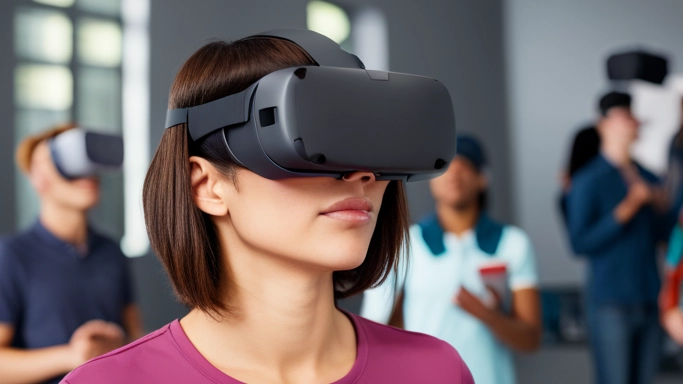As technology continues to evolve, it is profoundly transforming education at all levels, including higher education. Augmented Reality (AR) and Virtual Reality (VR) are at the forefront of this transformation, offering innovative ways to engage college students and enhance their learning experiences. In this article, we will explore how AR and VR are being integrated into college education, the benefits they bring to students and educators, the challenges they face, and the promising future they hold in reshaping higher learning.
The Integration of AR and VR in College Education
The adoption of AR and VR in college education is gaining momentum as educators recognize the potential of these technologies to revolutionize the way students learn and engage with course materials. Here are some key areas where AR and VR are making a significant impact:
1. Immersive Learning Environments
VR transports students to immersive virtual worlds where they can explore concepts that were once confined to textbooks. For example, history students can virtually step into the past to witness historical events, while engineering students can experiment with complex machinery in a risk-free environment.
2. Enhanced Laboratory Experiences
In science and engineering disciplines, VR allows students to conduct experiments and simulations that may not be feasible or safe in physical laboratories. Chemistry students can manipulate virtual molecules, and medical students can practice surgical procedures in VR.
3. Real-World Simulations
AR and VR enable students to interact with real-world scenarios. Business students can participate in virtual corporate simulations, medical students can diagnose virtual patients, and social work students can engage in realistic counseling sessions.
4. Collaborative Learning
AR and VR can foster collaboration among students, even when they are physically separated. Virtual classrooms and meeting spaces allow students to work together on projects, discuss ideas, and solve problems, promoting teamwork and communication skills.
5. Accessibility and Inclusivity
These technologies can make education more accessible to students with disabilities. Textbooks can be converted into AR format, providing audio descriptions or braille translations, and VR environments can accommodate various learning styles.
Benefits of AR and VR in College Education
The integration of AR and VR in college education offers a wide range of benefits for both students and educators:
1. Engagement
AR and VR make learning more engaging by providing immersive experiences that captivate students’ attention and spark their curiosity. This engagement often leads to increased retention of information.
2. Accessibility
These technologies can accommodate diverse learning needs. Students who struggle with traditional teaching methods may find AR and VR experiences more accessible and conducive to their learning styles.
3. Practical Experience
VR simulations offer students practical experience in their respective fields. For example, medical students can perform virtual surgeries, and architecture students can design and walkthrough virtual buildings.
4. Cost Savings
While the initial investment in AR and VR technology can be substantial, it can lead to cost savings over time. Virtual laboratories and simulations eliminate the need for expensive physical equipment and resources.
5. Flexibility
AR and VR can provide students with flexible learning options, allowing them to access course materials and experiences at their convenience, which is particularly valuable for non-traditional and online learners.
Challenges and Considerations
While AR and VR hold immense promise in college education, they also present several challenges and considerations:
1. Cost
The cost of implementing AR and VR technology can be a barrier for many educational institutions. This includes the expense of purchasing hardware, developing or licensing content, and providing technical support.
2. Faculty Training
Educators must receive proper training to effectively integrate AR and VR into their teaching methods. Institutions need to invest in faculty development programs to ensure educators can use these technologies proficiently.
3. Content Quality
The effectiveness of AR and VR in education relies heavily on the quality of the content. Educational content developers must create engaging, accurate, and age-appropriate experiences that align with curriculum standards.
4. Equity
Ensuring equitable access to AR and VR experiences can be challenging. Some students may have better access to technology than others, potentially creating disparities in learning opportunities.
5. Technical Issues
Technical glitches can disrupt the learning experience. Educational institutions must have robust technical support systems in place to address issues promptly.
Case Studies: Successful Implementation
Let’s explore some real-world examples of colleges and universities that have successfully integrated AR and VR into their educational programs:
1. Stanford University
Stanford uses VR to enhance its medical training programs. Medical students can practice surgical procedures in a virtual operating room, allowing them to develop critical skills in a safe and controlled environment.
2. Massachusetts Institute of Technology (MIT)
MIT offers a range of VR experiences, including a virtual tour of the International Space Station and a VR physics lab. These experiences supplement traditional coursework and provide students with hands-on learning opportunities.
3. University of Maryland
The University of Maryland uses AR to bring historical documents to life in its history courses. Students can use AR apps to view and interact with historical artifacts, gaining a deeper understanding of the past.
4. Penn State University
Penn State University has developed an AR app that helps students with visual impairments navigate campus. The app provides audio instructions and descriptions of campus landmarks, promoting inclusivity.
Conclusion
The integration of AR and VR into college education represents a significant leap forward in the way students learn and engage with course materials. These technologies have the potential to make education more accessible, engaging, and practical, providing students with valuable skills and experiences that prepare them for real-world challenges.
While challenges exist, continued innovation, investment, and collaboration among educational institutions, technology developers, and educators will likely pave the way for even more exciting developments in the future. As AR and VR become increasingly integrated into college curricula, we can anticipate a transformative shift in higher education, where the boundaries of traditional classrooms expand to encompass dynamic and immersive virtual learning environments, ultimately benefiting students and society as a whole.


